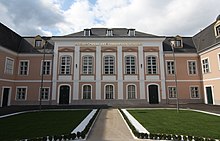Kaunitz-Wittgenstein Palace
The Palais Kaunitz (also Palais Kaunitz-Wittgenstein ) is a baroque palace in the Lower Austrian market town of Laxenburg . Presumably planned by the architect Domenico Martinelli , the Palais Kaunitz served several aristocratic families as a country palace, museum and later as a school before it became the headquarters of the International Anti-Corruption Academy (IACA) in 2010 .
history
In 1695 Leopold Philipp Montecuccoli acquired a vacant lot in Laxenburg, but was unable to complete the building he had started (about which nothing more is known today) until his death in 1698, which is why his widow sold the property on to Dominik Andreas Graf Kaunitz . The originally three-winged palace was built under this between 1698 and 1703. While Martinelli's authorship remains unclear, it is known that Andrea Simone Carove directed the work and that Pietro Bombelli took over the stone work. In the course of construction, Kaunitz acquired adjoining parcels several times in order to enlarge his property. It originated at a time when the imperial castles were also being built and the nobility settled nearby.
After the builder's death in 1705, his son Maximilian Ulrich von Kaunitz sold the palace to Leopold Schlik zu Bassano and Weißkirchen in 1722 because of inherited financial worries . After he died shortly after the purchase in 1723, the property changed hands in quick succession and was inhabited by the Lobkowitz and Chotek von Chotkow and Wognin families, among others . The Piedmontese ambassador to the imperial court in Vienna, Luigi Canale , finally used the building for a longer period of time and also made it available to his friend, the court poet Pietro Metastasio , who spent part of the summer here.
In 1775, Wenzel Anton Kaunitz , who spent part of his childhood as the son of Maximilian Ulrich von Kaunitz in the palace, acquired the property from Canale's widow. In the period that followed, extensive reconstruction work was carried out, most of which have been preserved to this day. In the interior, Wenzel Anton Kaunitz adapted the furnishings to the times, so that today it is classified as classicism . Among the busy artists was Joseph Pichler , who designed the frescoes in the stairwell and in the ballroom. After the death of Wenzel Anton, the palace was again sold and acquired by Franz de Paula Karl von Colloredo in 1803, who carried out some additions. Since he died in 1805 himself, the palace changed hands again quite early and was acquired by Nikolaus II Esterházy de Galantha in 1808 . Among other things, he set up a museum in the palace.
In 1895 the palace was acquired by the Wittgenstein family, with Klara Wittgenstein and her nephews Paul and Ludwig being the owners. From 1910 Klara Wittgenstein was the main occupant of the house. After her death, Klara Wittgenstein left the palace to her heir Paul Wittgenstein, who sold it to the Sisters of Mercy of the Holy Cross in 1935 . Until 1988 there was a school for the training of kindergarten teachers, as well as a housekeeping school, but also a secondary school with boarding school in the palace. The monastery also had a second location in Hinterbrühl in the Sauerstiftung , which also ran a primary school .
Current use
Parts of the palace were acquired by NÖ Landesimmobiliengesellschaf in the years before 2010 and rebuilt on behalf of the Republic of Austria and the Province of Lower Austria. Today they are the location of the IACA, which in Laxenburg offers master’s courses and anti-corruption training for international participants.
literature
- Marktgemeinde Laxenburg (ed.): A look at Laxenburg / A Glance at Laxenburg , 2014. pp. 82–85. ( German text )
- Springer, Elisabeth (2013). Formann, Barbara (Ed.): Laxenburg: Jewel at the gates of Vienna . Provincial Library Publishing House. ISBN 9783990281932 .
Web links
- Entry via Palais Kaunitz-Wittgenstein to Burgen-Austria
- Monument Day: Laxenburg - formerly Palais Kaunitz ( Memento from January 14, 2013 in the web archive archive.today )
Individual evidence
- ↑ a b c Laxenburg, pp. 116/117
- ↑ a b A look at Laxenburg, p. 84
- ↑ Laxenburg, pp. 149/150
- ↑ Entry on Palais Kaunitz-Wittgenstein on Burgen-Austria
- ↑ Laxenburg p. 605
- ↑ Laxenburg, pp. 191/192
- ↑ Laxenburg, pp. 192 and 606
- ↑ Report of the Court of Auditors (p. 155; accessed on August 9, 2018)
Coordinates: 48 ° 3 '57 .4 " N , 16 ° 21' 20.4" E
